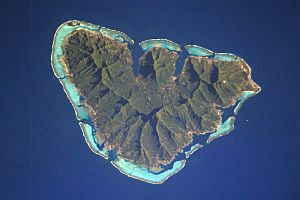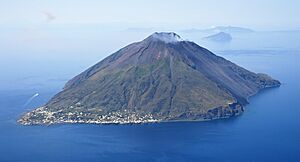Volcanic island facts for kids


A volcanic island is an island that was created by a volcano. These islands are often called high islands. This helps tell them apart from low islands. Low islands are made from sand, dirt, or coral reefs that have been pushed up. Often, these coral reefs grew on top of old, sunken volcanoes.
Contents
How Volcanic Islands Form
Volcanic islands are born from the deep ocean floor. They are made when lava and ash erupt from volcanoes. These volcanoes usually sit above a hotspot or a subduction zone. A hotspot is a very hot spot deep inside the Earth. A subduction zone is where one of Earth's large plates slides under another.
Some volcanic islands are quite small. They might only rise about 1 meter (3 feet) above the sea level. These are often called islets or rocks. Other islands, like Banaba or Nauru, are low islands but can still be quite tall. They can rise over 50 meters (164 feet) above the sea.
You often find both high and low islands close together. This is common in the South Pacific Ocean. Low islands often form on the coral reefs that grow around volcanic islands.
Living on Volcanic Islands
Volcanic islands usually range in size. They can be from 1 to 104 square kilometers (0.4 to 40 square miles). Islands that are big enough often have fresh groundwater. This means they have water underground that people can drink. Low islands often do not have much fresh water. Because of this, volcanic islands are usually better places for people to live.
Many volcanic islands have rough or mountainous land inside. They also have many different heights. Researchers have seen that these islands are often covered in thick tropical forests. These forests can make it hard to build homes in the middle of the island. So, most communities live along the coast.
Bigger islands might have rivers. These rivers can cause floods. Rivers also carry dirt and sand downstream. This can change the shape of the coast and cause erosion. Tall volcanic islands are often surrounded by protective reefs. These reefs create calm, shallow areas called lagoons.
Natural Challenges on Islands
Volcanic islands can face many natural dangers. These dangers might get worse because of climate change. Some of these dangers include:
- Volcanic eruptions
- Earthquakes
- Tsunamis (giant waves)
- Landslides (when land slides down a hill)
- Severe weather like hurricanes or typhoons
It is important to have plans to deal with these risks. One good way is to use "nature-based solutions." This means using natural processes and ecosystems to help. For example, restoring mangrove forests or coral reefs can protect against tsunamis and storm surges. Keeping natural areas that collect water can help stop floods. These natural solutions help keep people on the islands safer.
See also
 In Spanish: Isla volcánica para niños
In Spanish: Isla volcánica para niños

